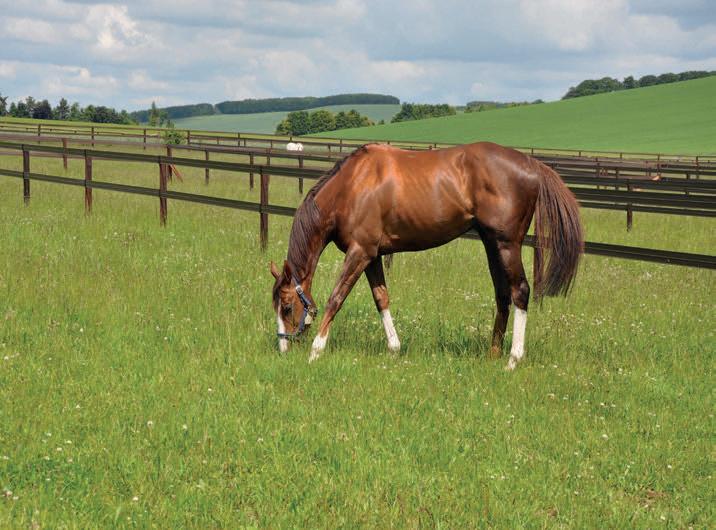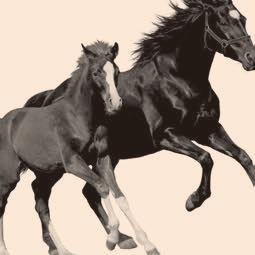
10 minute read
Paddock maintenance
Paddock management in a challenging climate
Words: Paul Overton
It may seem a distant memory now but the constant rain and wet weather earlier this year that led to flooding – and forced stud personnel to wade through wet gateways on poached ground – has now changed into a prolonged dry spell, with only the odd shower to soften the concrete-like hoof marks and ruts.
This is a common scenario in the Newmarket area, which is often wet. The sudden change, with the east winds drying the paddocks, has left a compact, hard rutted-surface, which can be damaging to young horses’ legs and feet.
Often the window to repair and prepare paddocks is very small and passes by very quickly. The unique equine calendar means that horses are out in paddocks in the most extreme weather conditions.
Autumn and winter weather can be challenging, with horse numbers putting pressure on the paddocks at all studs.
Stud managers often feel there is never enough paddocks and area to work with – extreme weather often puts considerable extra pressure on the stud manager’s shoulders.
In the equine industry, we do not have the luxury of holding horses in barns and turning out when the grass is fresh and conditions are warm and dry.
Covid-19 has put extra pressure on studs, not only with regard to losing staff members who are self-isolating, but also due to holding more horses on studs for a longer period, cutting down the rest periods for many paddocks.
Stud managers may have to plan for the worst and hope for the best.
Paddock assessment
It is always important to walk and examine the state of all of the paddocks on a regular basis.
Equine paddocks should have a safe, level surface and a ‘good bite’ of fresh grass
A paddock must have a safe, level surface and a ‘good bite’ of fresh grass, a simple concept but not easy to achieve. It is easy to let the grass levels drop which allows clover, weeds and moss to invade the grass sward.
Also, the mixture and the make-up of the grass species can change over time and after extreme weather conditions.
The most palatable nutrient-holding grass species for horses, like rye grass, fescues and smooth stalk meadow grass, are the most vulnerable to overgrazing, poaching and extreme damage.
The coarser grass, like creeping bent and couch grass, have underground rhizomes and produce little leaf area, thus making them very hardy and able to withstand damage from hooves, harrows and weather. But with their low leaf area that quickly fades in the early summer, they hold little useful nutrients to horses and can be unpalatable.
A paddock with a low grass level, dominated by coarse grass with shallow surface compaction, is the most common problem seen in equine paddocks and affects the visual look and performance of many paddocks.
The drop in grass levels can creep up slowly and result in a paddock turning into a ploughed field after a short period of grazing.
By looking at one square metre section of a paddock and discounting anything other than grass, what have you got? It should be 90- 95% grass and at least 75% of that should a palatable grass.
Clover is a positive in paddocks as a source of calcium and protein, but must not be allowed to dominate.
The word weed is subjective; dandelions and yarrow are herbs and a low level is fine but again, must not be allowed to dominate the grass. ››
HORSERAIL FENCING Horserail is the best solution to the problems generally associated with traditional timber post and rail, wire, tape and braided rope. Horserail provides an injury free, maintenance free, stylish and a ordable fencing system with a 30 Year Guarantee. Safety is an important factor with Horses. If a horse runs into the fence it will simply bounce back o it. Similarly, if a horse puts its leg through the rail, Horserail will not break, wrap or burn the horse’s body in any way. If you would like some more information and/or free quote, contact us today!

HORSERAIL


30 Year Guarantee
SAFE • STRONG • ELECTRIFIABLE
Paddock equipment is available to suit all budgets

Daisies, thistle, docks, buttercups and ragwort are most definitely weeds and invade where there is bare soil, prospering in low grass level paddocks by competing for vital moisture in periods of stress.
Also, it is important to look at the soil structure and grass rooting, as a healthy soil produces good grass and helps drainage. ››
Paddock inputs
Paddock inputs are the tools we have in a can or a bag to help improve our paddocks. The first thing we go for is usually a herbicide/weed killer as visually we hate to see untidy paddocks. However, there are drawbacks to their use.
Firstly, the withdrawal interval on most grassland herbicides is seven to ten days, but the common rule of thumb for horses is three to six weeks, to make sure any poisonous weeds are gone and the paddock is safe.
The second major impact of herbicide spraying is the need for qualified operator with a Pa1 and Pa2 certificate and equipment, or the hiring of a contractor to apply when the wind is low and conditions are right.
The weeds will re-establish on any bare areas from seed if there is no competition from grass; a thick grass sward will have very few weeds.
While weeds are the symptom of a problem, the problem most often is low grass levels and poor grass growth.
Often the best route to tackling a low grass/weed issue is to over-seed first, to establish new grass into the sward, and then tackle the weeds. The harrowing and seed preparation often damages the weeds and allows the new grass to establish. The other advantage of doing the seeding first is that many of the grassland herbicides require a one-month interval before over-seeding, which makes timing difficult and can take a paddock out of production for a longer period than ideal.
New grass seed is the most important input to equine
22% more treatment *
700 kg


Cinnamon leaf oil
one syringe treats up to 700 kg bodyweight Fragrant aroma to help aid acceptance
* than pioneer product (575 kg vs. Peptizole 700 kg per syringe)
First lineforlicensed treatment and prevention of recurrence of equine gastric ulcers
Proven bioequivalence to reference product

Two year shelf life



MONTHS
01 07 13 19 02 08 14 20 03 09 15 21 04 10 16 22 05 11 17 23 06 12 18 24
3 3 3 3 3 3 3 3 3 3 3 3 3 3 3 3 3 3 3 3 3 3 3 3
USE MEDICINES RESPONSIBLY. Manufactured and Distributed in NI by: Norbrook Laboratories Ltd, Station Works, Newry, Co. Down, BT35 6JP. Distributed in the UK by: Norbrook Laboratories (G.B.) Limited, 1 Saxon Way East, Corby, Northamptonshire, England, NN18 9EY. Legal Category: UK: Peptizole contains 370mg/g oral paste omeprazole licensed for the treatment of gastric ulcers and the prevention of recurrence of gastric ulcers in horses. For further details on this product including the dosage regimens, side e ects, precautions, warnings and contraindications please see the summary of product characteristics (SPC) available at www.vmd.defra.gov.uk/ProductInformationDatabase/Search.aspx | Advice on the use of this product should be sought from the medicine prescriber. | 4990-EQ-GB-v1b-16/04/20
Low grass levels due to weed and clover competition

grassland and the rebalancing of the grass make-up is the most important element of paddock management.
New grass seed should be in all budgets at the start of the season as the most cost effective input we have.
A basic soil test for ph, phosphate, potassium, and magnesium is always the best base for any fertiliser inputs.
Monitoring of the ph level is critical to equine grass and a ph of 7-plus should be maintained, as many equine stud farms are on a chalk soil type. Though important, lime application may only occasionally be needed. A balance of nitrogen, phosphate, and potassium is the most common product used and it does not have to be complicated or expensive.
The timing of any fertiliser application is the key to success, ideally a minimum of four weeks before grazing is needed, but a longer period may be necessary if dry weather is forecast.
Paddock equipment and operations
It is vital to repair any damage to a paddock as effectively as possible and within a small window of good ground conditions. The use of grassland tyres can prevent tyre damage to the soil surface.
There is a wide range of well-designed paddock equipment to suit all budgets and a good range of specialist contractors available to help get the work done.
Traditional chain harrows, tine harrows and knife harrows all have a role to play in the repair operation and would be a good starting point. These machines can be fitted with a seeder unit to allow over-seeding while harrowing.
There is also a good range of disc or slit direct into the surface drills available. For broad casting or slit drilling, the main aim should be to get good soil seed contact in order to achieve the best germination.
Rolling should be saved until the end of any programme, as it is easy to compact the soil surface and restrict grass regrowth.
Specialist machines like the ‘Aggravator’ or ‘Verti drainer’ can be used to break up shallow compaction and allow the soil to be aerated, but a simple slit roller in the right condition can be equally as effective.
Remember, the aim should be to get a safe, level surface with a final good grass cover.
The order of repairing, seeding and fertilising can be flexible, but should be done as soon as possible to allow time for germination and rest prior to re-use.
I would also caution against over-vigorous use of paddock sweepers, as a poorly set up machine can damage the palatable grass and increase the coarse grass level.
Action planning and conclusion
The key to good paddock management is to have a regular rotation of horses around the paddocks and a good plan of instant repair for damaged paddocks, as the window of opportunity can be very small.
The repair and rest periods are crucial and the longer horses can safely graze a paddock, the quicker they can return. These are the main indicators of a good grass paddock.
Planning of the gateways, water troughs and the placement of feed pots also have a big influence on the length of use of a paddock. A poached-up gateway and a wet pond near a water trough may only be 5% of the total area of a paddock, but may override the 95% of usable area and force you to move horses on early.

Equine Range Nature and technology - hand in hand
• The extensive range of HP fertilisers are especially suited to equine pastures and training areas.
By Appointment to Her Majesty The Queen Manufacturer & Supplier of HumberPalmers Fertilisers PB Kent & Co.
• The specialist Humber Palmers manufacturing process ensures every granule of fertiliser contains the optimum balance of nutrients for animal and pasture nutrition. • The unique organic based ensure steady grass growth and healthy pasture. • Includes a wide spectrum of natural Trace Elements such as Zinc, Copper, Cobalt and Selenium which all contribute to overall animal health.
For further information and advice please contact: Gavin Young on 07763 567043 Email: gavin.young@humberpalmers.co.uk Visit: www.humberpalmers.co.uk







